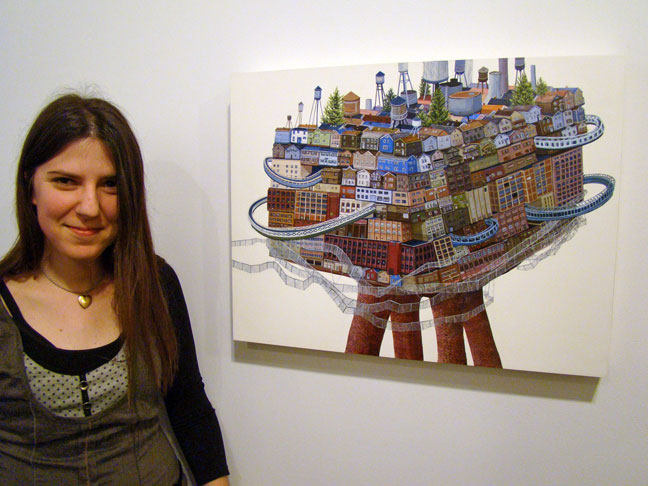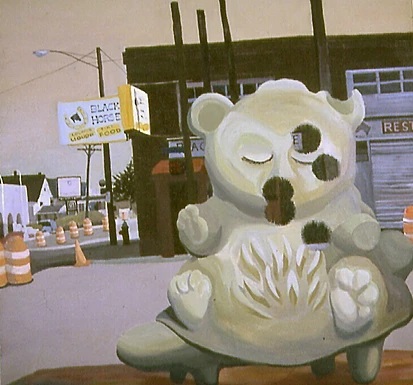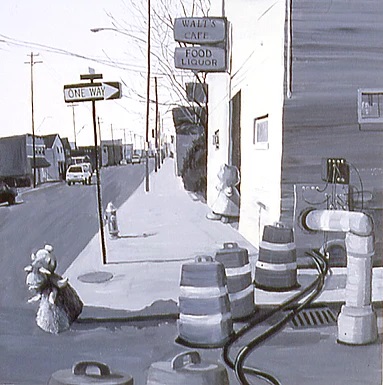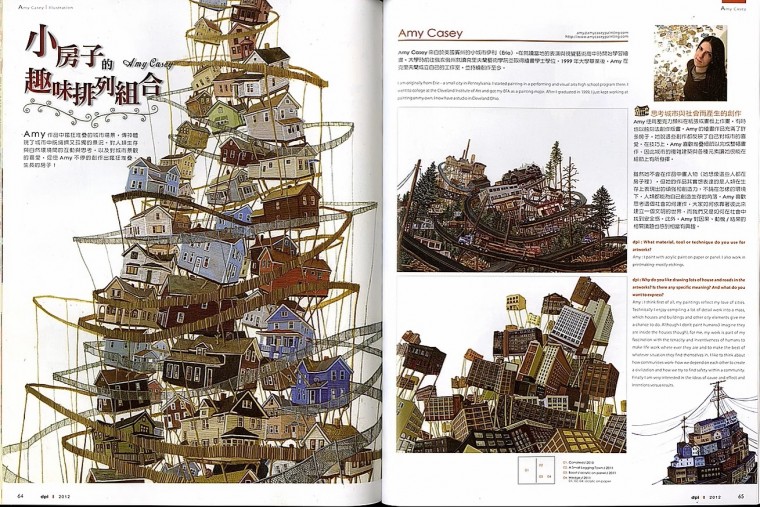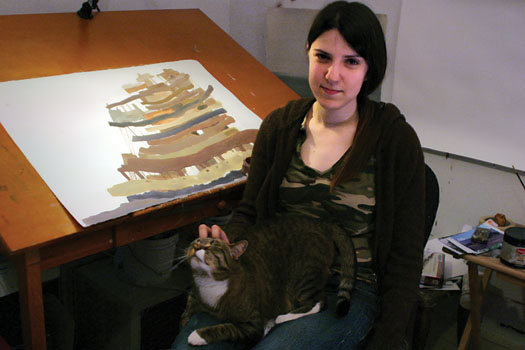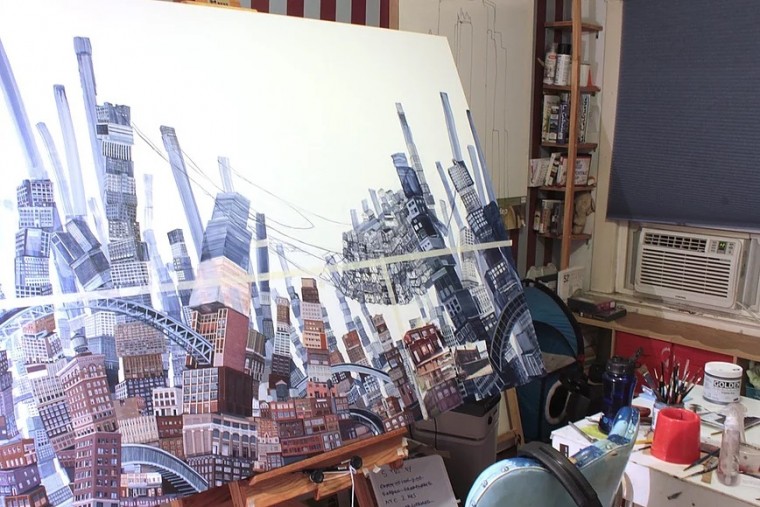Interview with Featured Artist, Amy Casey,
conducted via email by Dave Mehler for TCR
TCR: My son was seven and one day we were walking somewhere and he said, dad, where is the line for people who want to be artists? I’d like to get in it. So how was it for you? When did you know you wanted to be an artist, how did you get your start, and who helped you along the way? What were and are your influences?
Amy Casey: I thought I wanted to be an artist as a child in a wishy-washy kind of way—it sounded like a good gig. I didn’t know any artists and wasn’t exposed to all that much art as a kid, but I have always loved making things. When I was around eleven or so, I decided being an artist was unrealistic and I thought it would be much easier to make a living as a writer, because my mom was such a big reader, we were big readers, we were always surrounded by books and went regularly to the library. I didn’t know any writers either, but somehow it seemed more possible than art- I found tangible evidence of their work everywhere! Now that I know writers, I know making a living as a writer is it’s own complicated magical mess, not unlike artists. Anyways, eventually I was sort of dragged back into art. A counselor suggested impatiently that I choose art as an elective when I dithered over making a choice. (My suspicion is that it was probably first on the list, A) I have always tended to go with the flow, I figured why not? In that art class I met a kind art teacher named Mary Pat Haven who felt I should apply to the advanced art classes in the School of Performing and Visual Arts attached to the school. Okay. So I did, and I got in. The teacher in the advanced class, Ken Kopin, was always challenging me to apply to shows, to opportunities. He suggested the Pennsylvania Governors School of the Arts, which was a summer program for high schoolers across the state, and I was accepted. There I met a fantastic group of young artists and actually began to believe that a life in the arts was something that was possible. I think it was around that time that I decided to be an artist. So I went to art school and then just did my best to keep working and growing. I think to become an artist, it helps to be a mix of somewhat delusional-to have no doubts that you will continue on as an artist despite the high odds of failure -and to be steeped in practical realities- How are you going to pay the bills? How are you going to get things done? Also I feel like one of my characteristics is dedication/determination. And that helps a lot. I have loved many artists over the years, some of my favorite artists are Morandi, Rousseau, Bill Traylor, Charles Burchfield, Kim Dorland, Amy Cutler, Kiel Johnson, Phillip Guston, Indian Miniatures by various artists, Peter Doig, David Hockney and on and on. I don’t think that I ever try to consciously emulate any of them, but they do make me feel excited about being an artist, excited about getting to work.
TCR: What are the most important 5 things we need to know about you—if you want to go with 3 or 6, that’s ok.
Amy Casey: I’m not sure if it’s important to know anything about me. I spend a lot of time alone, live in my head and over-think a lot of things. I both go with the flow and then feel a lot of anxiety. I still have that love for making things.
TCR: In your early early work you have a mostly black and white urban landscape with stuffed animal duality-like creatures instead of people, along with mutant and scary plant life. Is this a sort of expression of innocence and experience sort of scenario; chaos and nightmare in the midst of a toxicity of decaying civilization? Is this you processing Cleveland?
Amy Casey: Well, I had just moved to a more urban part of Cleveland when I started that work. I was in love with the landscape there and wanted to include it in my work. A number of bad things were going on with me personally and at that time I was trying to change my work from more personal/confessional mode to a more universal mode, because I had realized I didn’t want to tell people what my paintings were about and that is not a constructive place to be in. A number of natural disasters were happening back then—the Indian Ocean tsunami in ’04, Hurricane Katrina in ’05. I began thinking a lot about the precarious world we were living in and how things could be turned upside down in a moment. So that’s partly what those were about.
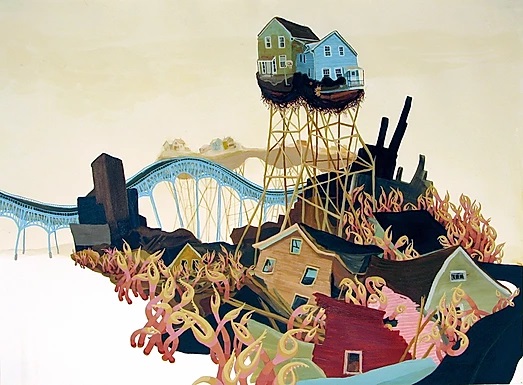 Amy Casey, Surrounded, 2007, Acrylic on Paper, 22″ X 30″
Amy Casey, Surrounded, 2007, Acrylic on Paper, 22″ X 30″
TCR: What was it like for you to predict, through the subject matter of your art, the economic crash of 2008?
Amy Casey: Hah, well I don’t know. Leading up to it—say in 2006 onward I seemed to know more and more people losing houses to foreclosure, so the idea of housing being fragile was on my mind. And then the Bush administration was also weighing heavily on me. It just felt like there was so much that was wrong. (Though current days make it pale in comparison) Sometimes it seems like I predict all kinds of doom, for instance around the time of a bridge collapse in (I think) Minnesota, I had a solo show open and in that show there was an image of a collapsing bridge. And then I was painting flooding, and flooding is happening. But my work is partly inspired by the anxiety of news and though I’ve never specifically made a painting about a real event, well—bad things happen all the time: flooding, infrastructure crumbling, markets going up and down. So it’s not super hard to predict that they will happen again I guess. I do feel very sad that I started painting forests inspired by the beautiful woods I explored in Finland, and now when I’m painting them I cant help but think a bit about the dire straits the Amazon may be headed towards. Here’s hoping it doesn’t happen.
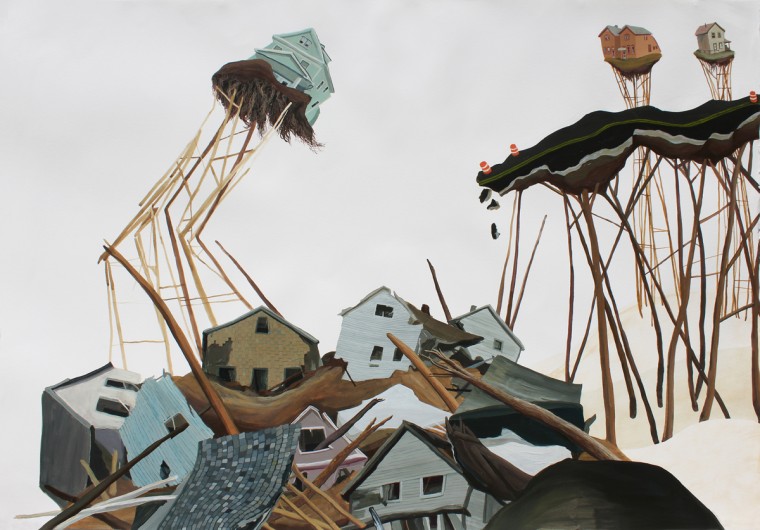 Amy Casey, Downfall, 2007, Acrylic on Paper, 30″ X 42″
Amy Casey, Downfall, 2007, Acrylic on Paper, 30″ X 42″
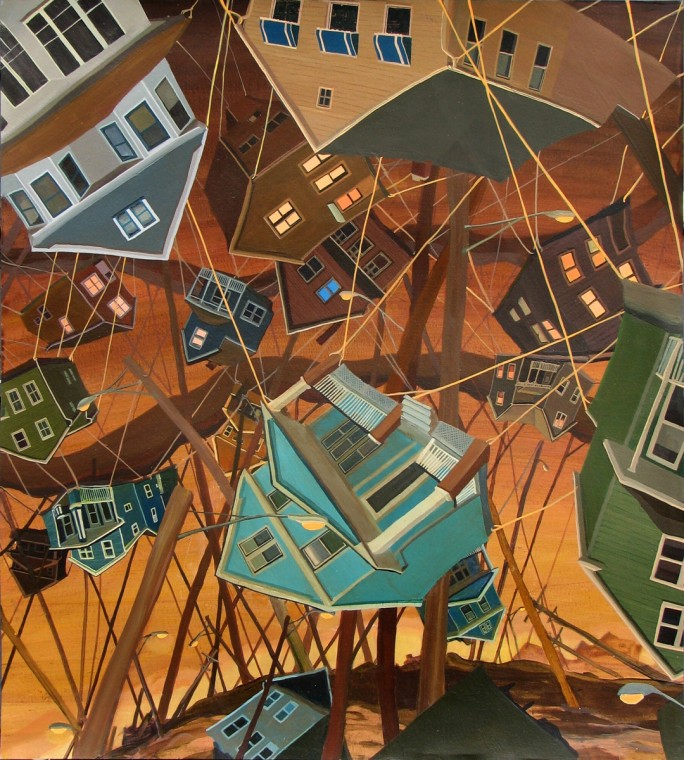 Amy Casey, Tiltawhirl, 2007, Acrylic on Paper, 22.5″ X 19.5″
Amy Casey, Tiltawhirl, 2007, Acrylic on Paper, 22.5″ X 19.5″
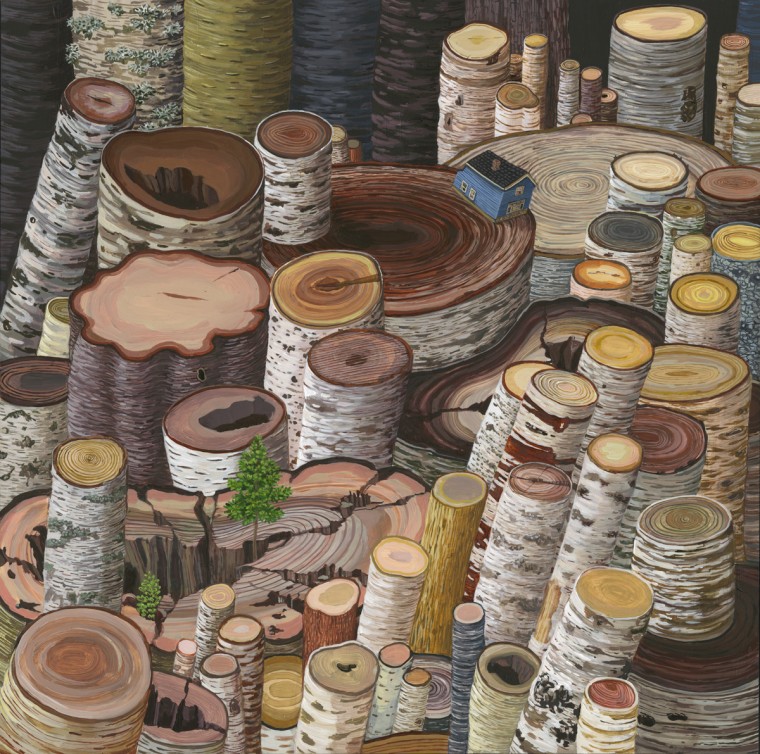 Amy Casey, The back of beyond, 2018, 16″ X 16″
Amy Casey, The back of beyond, 2018, 16″ X 16″
TCR: You were the first of two twins to be born, you refer to yourself as a and her as b. (I’m wondering if her name starts with b). What does she think of your work as an artist? Is she artistic? Were either of your parents?
Amy Casey: When my twin and I were born, we were a month early and also we had been predicted to be one single, fat, boy. With no pre-prepared names ready, we were branded with little bracelets that read Baby A and Baby B. Baby B. eventually was named Beth. I wouldn’t want to speak for my sister for how artistic she feels, but if she makes art, she doesn’t share it with me. She is supportive of my work. Same could be said of my parents. I think the idea of me pursuing art made them nervous because they had no connection with art or artists, and didn’t think it was a realistic plan but they never discouraged me, or told me not to do it.
TCR: You’ve seen some success as an artist, which I’ve gleaned from not only the gallery showings, representation and exposure but with national and international attention. Articles are being written and publishers are requesting and using your artwork for covers of books and it seems you are especially getting some attention in Japan and China? What would you like to comment about this? Are you surprised? Gratified? Nervous?
Amy Casey: Success is pretty relative. I am super lucky that I can make a living as an artist. The world is a lot smaller in some ways with the internet, so it’s easier to get digital images of work in all sorts of unexpected places. Of course I’m pleased when people connect with my work or want to share it. When other people can see some of their own experience inside my own, it makes the world seem like a less lonely place.
TCR: Do you read a lot of poetry? What do you read?
Amy Casey: I have started reading poetry again after a long hiatus, thanks to a poet friend who I would bug for recommendations. I love playful poetry the best most of the time. some poets I been enjoying in no particular order:
Ron Padgett, Harryette Mullen, Sparrow, William Carlos Williams, ee cummings, Jack Gilbert, Frank O’Hara, Ocean Vuong, Bob Holman, Mary Oliver, Bill Knott, Saul Williams…
TCR: I noticed on your blog it’s almost like a time card with notes about what your listening to, how many hours you put in and what you’re reading. Can you give us a feel for what an an average good day creatively is like for you. Maybe some hints about what drives your inspiration and feeds you creatively. Obviously concerns about the environment and the impact but also the welfare and well-being of humanity as it lives, works, and creates must be in the forefront?
Amy Casey: Oh I forgot about my blog! How many times has that sentence been typed! Studio life has a lot of habit and repetition for me—I need a framework and structure to help propel myself through time because I can get lost in details and distractions. Though I don’t necessarily think it’s a virtue to put in as many hours as you can, there are times when I need to to hit deadlines. When I track my time, I have a better handle on how things are going in that regard. The “what I’m reading” note was a challenge to myself to continue to read about art and outside topics because though I love books, it falls to the wayside when I am stressed.
Average days in the studio vary greatly depending on what stage of work I am in. A good day in generating new ideas, plotting new work is very different to days in which I’m working through a painting, making decisions in the moment, reacting and getting lost in mark making, or working up walls of detail. That process can be meditative but also physically and mentally challenging. To sit in a chair for long stretches hunched over a painting can be painful. I have always been drawn to repetitive processes I can lose myself in—I loved quilting—all hand stitching—though I no longer have time for it. I love gardening, which after the planting and shifting things about is for me, mostly weeding weeding weeding. So painting processes that are slow and a little tedious don’t bother me most of the time, though of course you can get get restless, then you might switch to another painting.
Sometimes a painting does what you imagine it will, but more often, it talks back at you and that can be a dance or a dirty wrestling match depending on the mood of the day. I once saw a nature documentary while I was in the middle of a painting of water that was not working. The documentary had this polar bear swimming in a huge body of water and the narrator was telling the viewer that with less sea ice available, the bear will have to keep swimming until it finds a place to rest or drowns. And it’s being over dramatic but I was staring at that bobbing bear head and thinking I am that bear! ha ha. I was on a deadline and I had invested so much time in the painting I felt I couldn’t abandon it, I had to just keep on working till I righted it which didn’t seem like anything I could see on the horizon. Sometimes you just don’t know how to finish a painting or how to fix something that goes pear shaped. Times like this don’t feel like a good day, but it’s something that has to be gone through from time to time to make things or to grow. If and when you figure it out and finally get to that other shore, it is intensely satisfying. That painting was All at Sea. Which I think turned out all right in the end, but the temptation to throw it into a sea was very strong. Luckily I only live near a great lake.
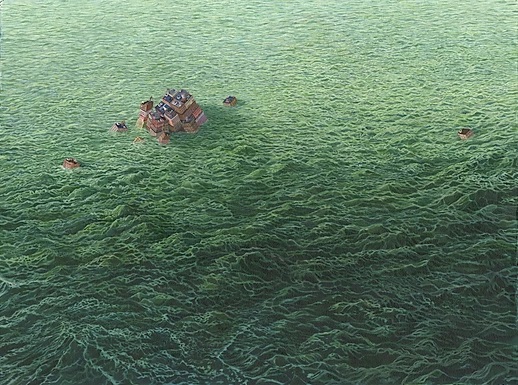 Amy Casey, All at Sea, 30″ X 40,” Acrylic on Paper
Amy Casey, All at Sea, 30″ X 40,” Acrylic on Paper
Inspiration for work though is often much simpler than non-artists think. It’s not always a grand plan or vision. A lot of paintings are started because of something that didn’t work in another painting, or a path that wasn’t taken, or a variation on a composition. Often one work leads into many others.
You might see a great color combination in the world somewhere, or in another piece of art and you just want to work it—I made a number of paintings inspired by the color palette of a dinner I once ate. Salmon with wasabi and purple and golden potatoes. Sometimes you just play with materials or try new techniques, and that might lead you in a direction.You may see something in the world that you want to include in your work and every now and then compositions or whole paintings just pop into your head. I find that is rarer for me these days, but used to happen to me frequently when I was riding the train home from work. Sleep deprivation also fed into that, but I can’t endorse that in good conscience.
TCR: Tell us something about your medium and how that affects your work. You say that a lot of the buildings you’ve painted are actual buildings in and around Cleveland, and up until recently your work was on the smaller scale of paper and ink and acrylic and I notice you’re starting to create larger pieces on a grander scale. I wonder if success has allowed you to find more time to work on more ambitious pieces recently?
Amy Casey: Acrylic paint works best for my way of working, I like building up all these small details (perhaps to excess sometimes) and would probably accidentally wipe out my work in oils because I tend to lean on my work. Hah, bad habits. The drying time also works best for me as I usually work till the last minute. I’m not a painterly blender, to my sorrow. So acrylic paint makes sense. I have also been dabbling with airbrushes, but just at a very beginning with it.
I also made some bigger pieces back when I had very little success…some work just feels like it should be big. When I worked day jobs, they were part-time on/off jobs like art installation. So I just had very little money and picked stuff like furniture out of the garbage a lot more often. But I did have good sized pockets of time to create in. Regular shows and sales can be a great motivator but it can also create limits on time to work on things, unless you have a robot arm or a herd of assistants or are making so much money per painting you just do a few a year. I am not at that point.
TCR: What do you see and hope for happening for you personally and in your career 2,5, or10 years in the future? Do you set goals or think mostly about the moment…? Looking back over the scope of your work as a whole I see some of your concerns, especially with forests and the oceans in the last two years particularly.
Amy Casey: I really don’t know. Like a lot of people, I don’t plan very far ahead. In 2, 5 or 10 years I hope I am still painting. 😉
TCR: Obviously, as you hint at, it’s a bit of a scary time with the political polarization in the country at the moment and many are feeling like it’s doom and gloom and weight like we might be on the verge of some apocalypse, but some thinkers are coming out with books stating things globally have never been better. Hunger and abject poverty worldwide has been halved in the last ten years, clean water has never been more available, diseases and the conditions that lead to them are being addressed and reduced or eradicated, violence is at a lower rate than ever, forests are actually on the rise. Historically, and relatively speaking, wars and violence are down in the last 70 years. Thinkers like Steven Pinker have been documenting this in books, Bjorn Lomberg, a statistician and think tank consultant (the Copenhagen Consensus Center), has been working with Nobel prize-winning economists to offer consultation to countries on how best to use their limited resources, and how best to prioritize and tackle global problems in the same way (he wrote a book called, How to Spend 75 Billion to Make the World a Better Place). Would you say you are an optimist or a pessimist? Your art is full of social and environmental satire and commentary, often wry humor in choice of subject matter, execution and choice of titles. You’re a prophet who is offering warnings. Would you say you feel more worried or hopeful at the moment?
Amy Casey: I’m not an expert on any of these things. Though all news like this usually has a point of view and a counterpoint is available. For instance in the statistic that forests are on the rise, in the bit of reading I’ve done about it, the accounting process isn’t straight forward and the rise includes tree plantations in which there is often far less diversity than a natural forest. That lack of diversity means they support many less creatures than the old growth forests they sometimes replace. It also makes them more vulnerable to climate change or any other disaster or blight that occurs. Also young forests and tree plantations may not even absorb carbon in the same way that old growth forests do. So… it’s complicated. I don’t know what position is right, but most things are good news/bad news. I am not a total optimist or pessimist. I’m more of a “we’ll see what happens” person. I think it’s important to think about how things feel though, because even if how things feel is not how things are, how things feel is often what drives us to take action or not take action.
I read a lot of news; it is a time-killing stresser for me—everyone has vices—and it feeds into my work. Not usually directly, though all the algae bloom stories about Lake Erie have turned some of my water paintings green. 🙂 . Usually it is more an underlying feeling that infects my work in one way or another. As a humanist, I feel like we have to take care of each other, and it doesn’t always feel like that is happening at the moment. I do worry about humans, where we will be in 50 years seems more tenuous than ever. I think it’s terrible and shortsighted some of the things that humans are doing to the planet and each other. I recognize that there are many good things humans do and net improvements for humans are being made, but it is hard for me to be an optimist. But I would like to be one and I don’t think things necessarily have to end up badly.
TCR: Do you ever face criticism for being so direct in your art as a cultural commentator? Tell us about your obsessions? Is this a way you deal with and process the world as you see it around you? Or would you consider yourself to be a town crier to effect change and tell the truth as you see it?
Amy Casey: My work is how I process the world around me. I’m not an expert on anything, and I don’t pretend to have any answers. People have interpreted my work in different ways, and I don’t want to tell people what to take away from it. Sometimes as I work on a painting, it can shift between seeming positive and negative several times as I am working on it. I mean there’s a lot to be concerned about out there, but you can’t make your life all about doom and gloom. Or at least I certainly don’t want to. I hope that people can see a sense of humor in my work, even if it can be a dark humor. Part of my interest in including nature in my work is in feeling the strange split between loving the peace of mind that the natural world brings, and at the same time feeling like humans and the natural world are intent on killing each other. I try to find a space to rest between those two sides. Another part of my interest to include more nature is because I love forests and it is challenging and interesting and fun to paint all those textures and forms. There’s a joy in that. If I can capture something of what it’s like to be alive in this time, and create a satisfying painting, I’m happy.
Also in terms of what I had mentioned to you in another email* about failure is more in not finishing work, I do believe that but with a caveat—I have occasionally overworked paintings to death and not known when to quit. So my tendency to try really hard does occasionally blow up in my face into trying too hard.
*Note: Amy is referring to an email exchange we had toward the end of the interview and she was explaining why she hadn’t responded sooner—here is that exchange:
Amy: I have a big painting I need to finish that has been fighting me, been dragging me down.
Dave: Sorry to hear about that Amy but you’ve piqued my interest a bit how that could happen. I mean we never hear about the failure in visual art and rarely see the progression toward a finished piece…
Amy: There’s frequently a point in the middle of painting where you start to despair that you will never be able to steer the darn thing home. Failures are mostly when you just give up, though some finished paintings are definitely better than others. I am pretty determined. Painting and weeping, ha ha ha.
This is the painting she was working through, after completion:
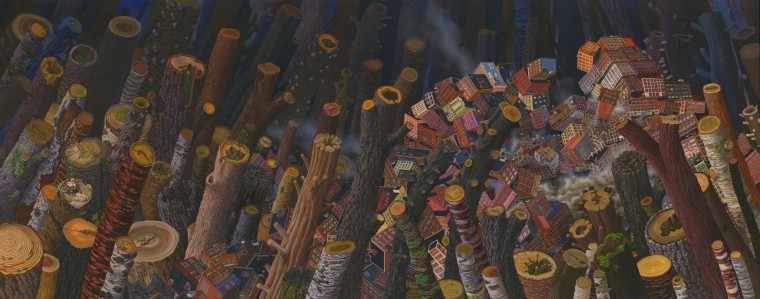 Amy Casey, Forest of Uncertain Things, 2019
Amy Casey, Forest of Uncertain Things, 2019
Here is a short (5-6 minute) video clip of Amy Casey speaking from her studio in 2011 with Ted Sikora after winning the Cleveland Arts Prize: Amy Casey video interview. Another one from an artist in residence gig in Anchorage, AK: Artist Residency video
Her website and contact information is here: https://www.amycaseypainting.com/

